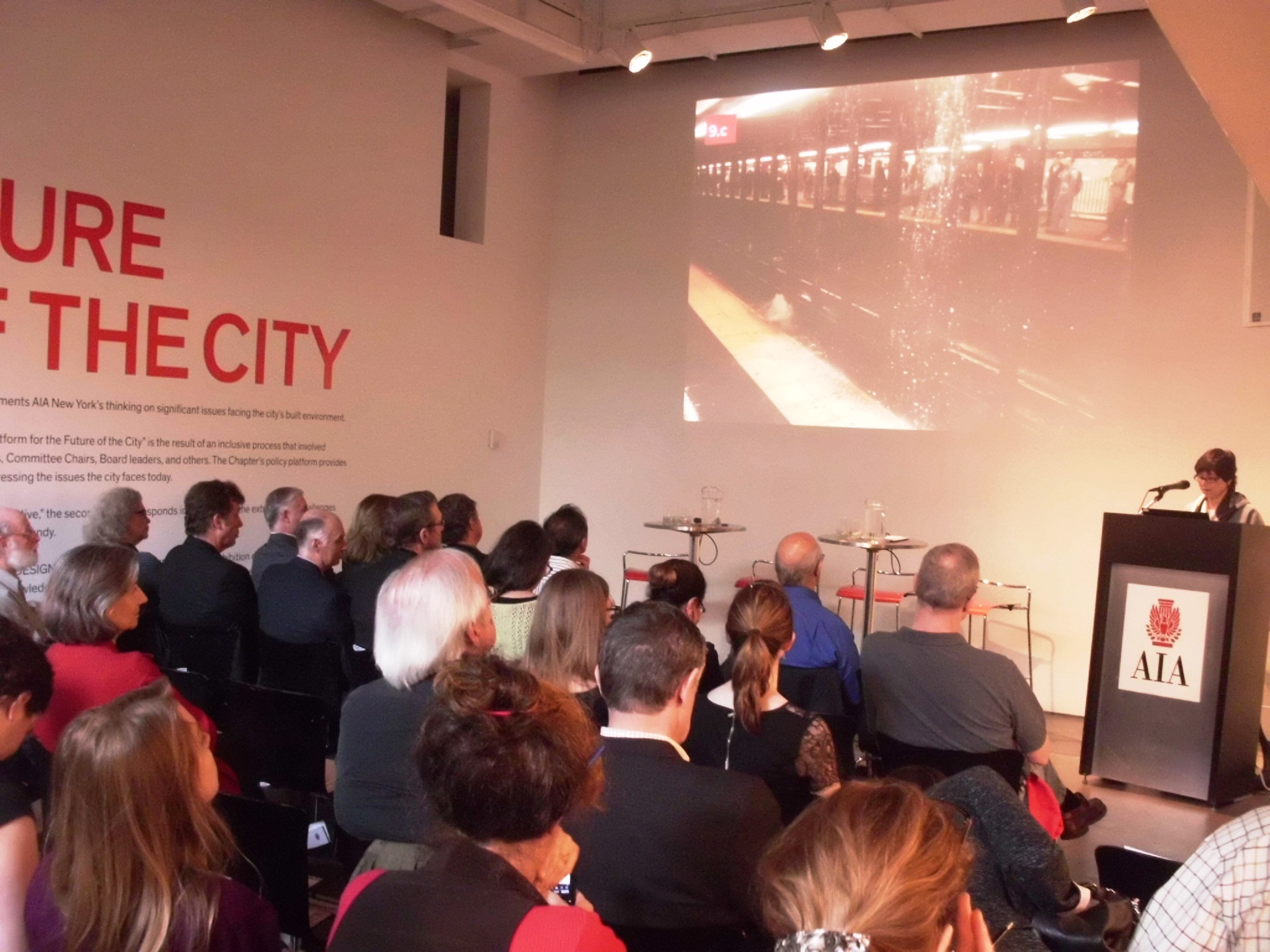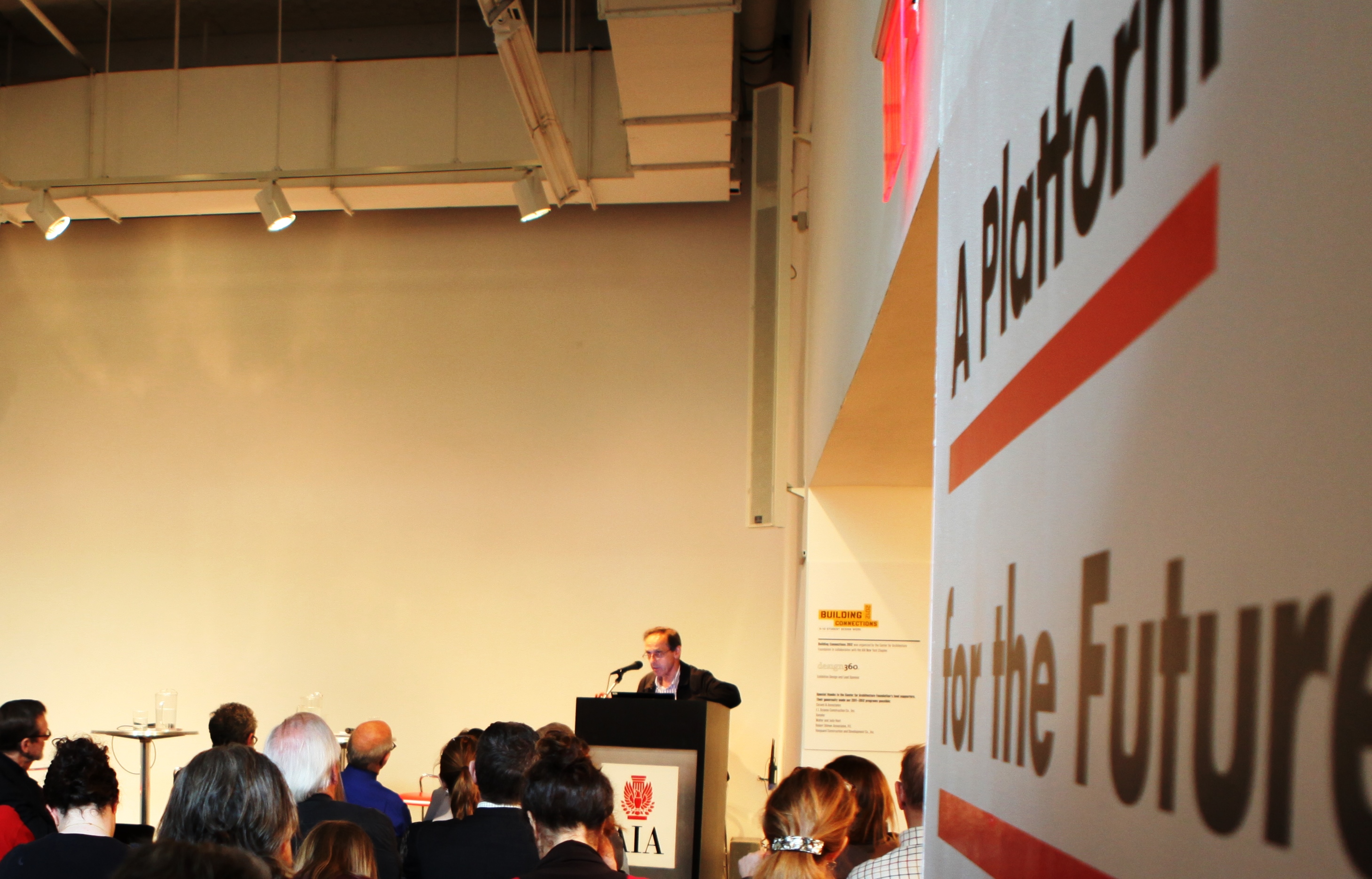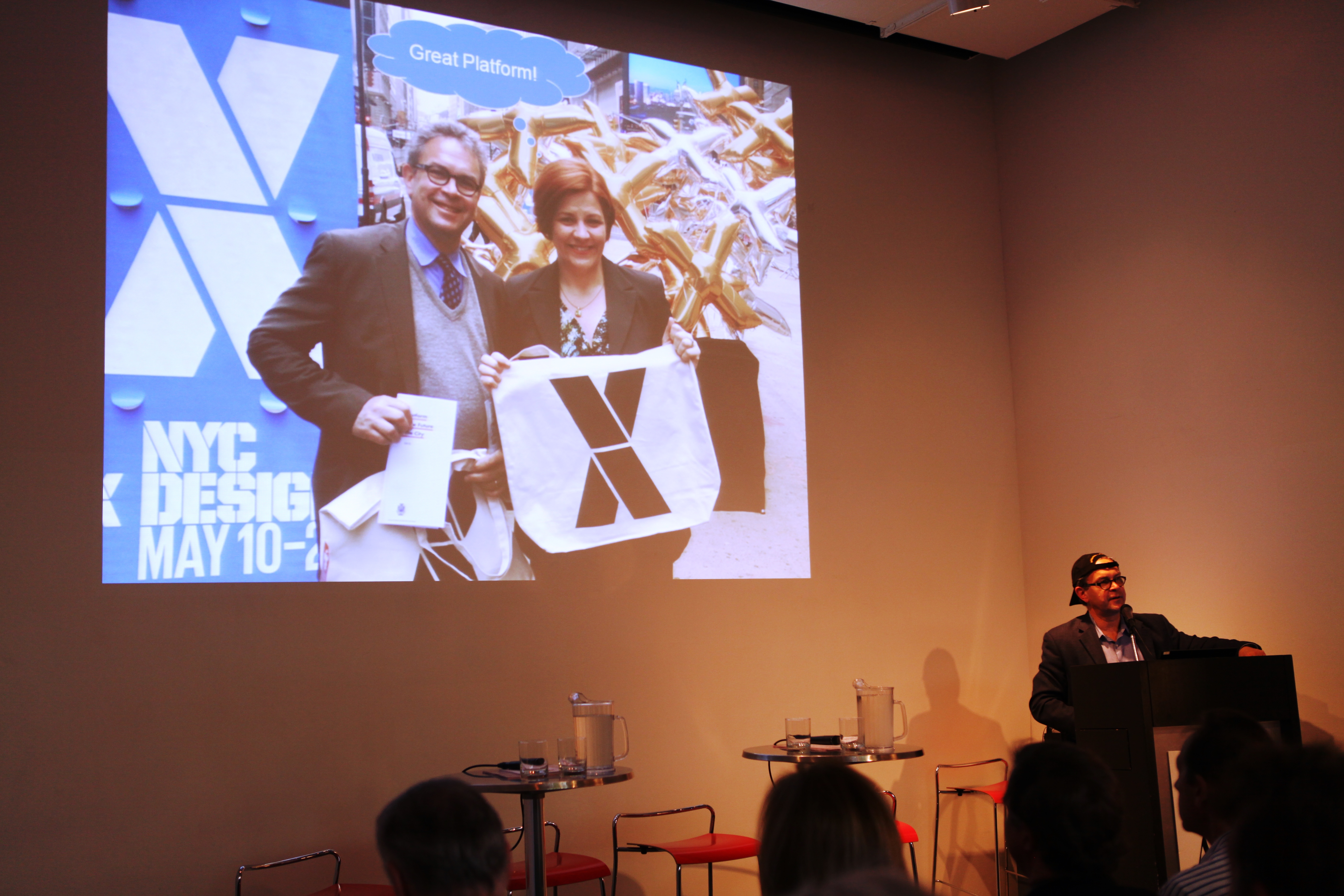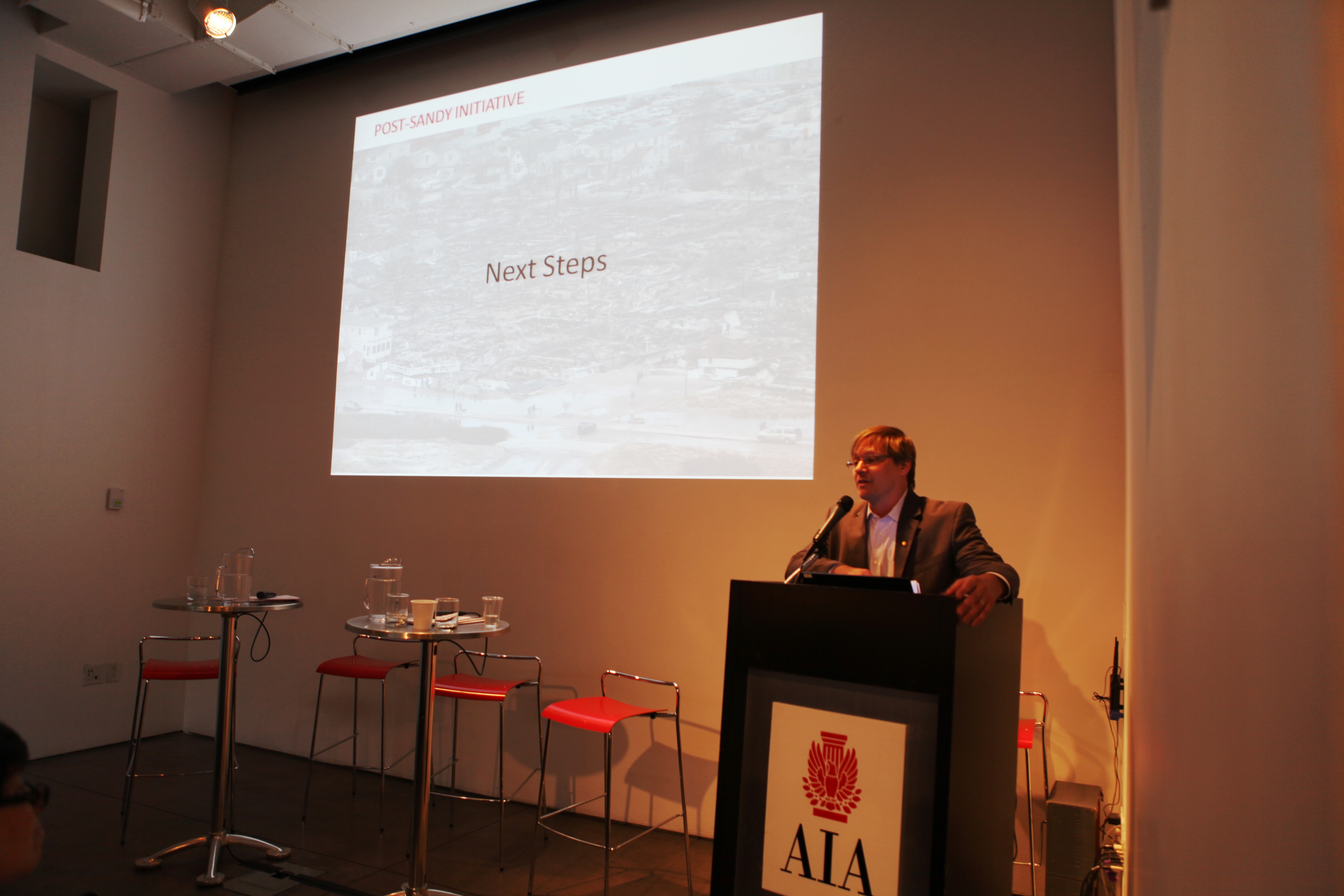by: chas
Cross-disciplinary. Streamlined. Flexible. These are the principles New York architects hope to see in the city’s future, as evidenced by the major themes presented at The Future of the City Symposium on 05.11.13. Taking lessons from their own experiences, four present and former AIANY presidents, along with leaders from AIANY’s Post-Sandy Initiative, spent the afternoon discussing the issues related to architecture, planning, and design that will be facing the New York’s next mayor and the city as a whole.
Jill N. Lerner, FAIA, 2013 AIANY President, praised the creation and release of A Platform for the Future of the City. The platform highlights 30 key issues for the upcoming citywide elections that suggest ways to improve New York’s role as a global city in a changing society. Lerner noted the importance of making the public aware of the importance of design issues, and opened the symposium by asserting that “the voice of an architect at the table can change the conversation.” Her words were reiterated throughout the event.
This portion of the afternoon was divided into four sections; Our Buildings, presented by Joseph J. Aliotta, AIA, LEED AP BD+C, 2012 AIANY President; Our Neighborhoods, presented by Sherida Paulsen, FAIA, 2009 AIANY President; Our City, presented by Margaret Castillo, AIA, LEED AP, 2011 AIANY President; and Our Globe, presented by Lerner. Each speaker proposed an expanded presence of design professionals in city government, and a closer relationship between not only those professionals and politicians, but also with scientists, business owners, and residents in order to streamline, expand, and update the current policies regarding urban design.
In all cases, this involves a push for flexibility and for professionals in all sectors to break out of their occupational silos. Nothing can remain in a tightly defined box if our city is to move forward. Paulsen summed up the messages of the symposium well when she said, “Our neighborhoods are not going to be beautiful, wonderful places just by protecting them,” a sentiment that could easily apply to any topic discussed throughout the day.
Between the two halves of the afternoon, David Burney, FAIA, delivered the keynote address emphasizing five major goals for the next mayoral administration: maintain capital investment; fund affordable housing; expand and improve public transit; sustain PlaNYC progress; and support cultural institutions. In the long term, Burney asserted that “hard” and “soft” infrastructures – physical and institutional networks of a society, respectively – must both be addressed to keep the city functioning successfully and globally. Burney also asserted that cultural institutions play an essential role in the overall functioning of the city, citing studies that find correlations between culture, quality of life, and economic development. Burney’s recommendations stressed thinking in the long-term and in a global context, particularly when it came to affordability and flexibility in the realm of housing: “If we cannot house our population in an affordable way, our future as a global city is under threat.”
No single event in the past few years made clearer the need for long-term thinking and adaptability than Superstorm Sandy and its impacts on New York, the metropolitan area, and the entire Eastern seaboard. Four leaders of Post-Sandy Initiative working groups shared the results of design charrettes focused on the sectors of housing, critical and commercial buildings, transportation and infrastructure, and the waterfront.
Seeing the innovative sketches and concepts proposed by the dozens of designers who participated was a highlight of the afternoon, and further underscored the need for better integration of architects and designers into the government sphere. Elected officials currently formulating ways to create a city for the changing climate and the charrettes demonstrated that New York holds strong assets in its exceptionally large population of design professionals, and the inspiring solutions they can produce when working together, even in a short amount of time. Calls were made once again for adaptable policies and design, with Denisha Williams, ASLA, of the waterfront working group advocating for holistic systems and the important conviction that no piece of design in this context should be single-purpose.
The symposium concluded with a presentation of sobering statistics on climate change, and a call to action from Illya Azaroff, AIA, founding co-chair of the AIANY Design for Risk and Reconstruction Committee (DfRR). Azaroff pushed for education, advocacy, and action in these very real and urgent matters.
Lance Jay Brown, FAIA, founding DfRR co-chair, delivered closing remarks, wrapping up the afternoon with a final appeal for a shift in language and perspective to bring together disparate groups working towards the solutions to the issues facing our changing city. He urged all involved in these decisions to seek an end to the debates over how best to approach the issues, and instead to move towards an appreciation of the collective brainpower at their disposal: “Just do it all. Let’s connect the money to our expertise.”
Cassie Hackel is a community development professional with a background in multidisciplinary urban studies. She is currently a research associate with Plastarc, Inc. This is her first article for e-Oculus.
Event: Future of our City Symposium
Location: Center for Architecture, 5.11.13
Speakers:
1:00 PM
Platform Panel
– Our Buildings: Joseph J. Aliotta, AIA, LEED AP BD+C
– Our Neighborhoods: Sherida Paulsen, FAIA
– Our City: Margaret O’Donoghue Castillo, AIA, LEED AP
– Our World: Jill N. Lerner, FAIA
Moderator: Rick Bell, FAIA
2:00 PM
Keynote
David Burney, FAIA
2:15 PM
Break
2:30 PM
Post-Sandy Panel
– Housing Work Group: Mark Ginsberg, FAIA
– Transportation & Urban Work Group: Jim Wright, AIA
– Critical & Commercial Buildings: Raymond Skorupa, AIA
– Waterfront: Denisha Williams, ASLA
Moderator: Ernie Hutton, FAICP, Assoc. AIA
3:30 PM
Next Steps
Illya Azaroff, AIA
3:45 PM
Closing Remarks
Lance Jay Brown, FAIA
Organizer: AIANY















